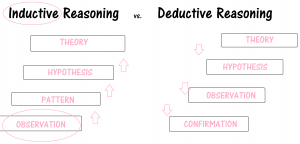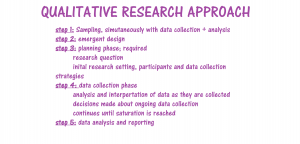|| Research Methods as a Dietitian to Be.
Research is extremely important for Dietitians. Even if you are not doing research in your Dietetics career, you actually kind of always are. Since a primary value in Dietitians is obtaining evidence based research, it is important that we always know where our information is coming from and that we have reliable sources.
It is important that we are always providing the best available information for our clients, so research is vital as a Dietitian. We need to understand the difference between a sample size of 10 (n=10) and a sample size of 2000 (n=2000). We need to realize what a systematic review is, and how to understand it. Here, I want to show you how we do that.
Qualitative Research
– this type of research is different than quantitative research, because qualitative research involves narrative data, as opposed to numbers and numerical data (in quantitative)
– this research allows you to explore processes that underlie human behavior, and can include focus groups, interviews and case studies.
Nature: Subjective and Multiple
Research Goal: Explanation, Discovery and Meaning
Relationship: Interactive
What Situations is Qualitative research good in?
– to determine if something from a lab setting would work in a community setting
– to see how something from one population would sufficiently transfer over to another population
– to evaluate new policies and determine whether they are effective and being used.
Benefits of Qualitative Research include:
- having a flexible design, allowing you to change things throughout the process. This means that you can change the structure and design of a study throughout the study, as you obtain more information and resources.
- if often allows you to see bigger picture ideas; some things cannot be explained well or at all by numerical data (quantitative data).
- complexity can be explained through research questions and interviews.
…but it also includes some limitations…
- cannot determine casual explanation in natural setting
- cannot study the process or natural history of something
- cannot understand the culture, meaning of something or significance of something to a particular person
Inductive Vs. Deductive
Inductive: Begins with an observation, then leads to a theory. Instead, of starting with a theory and ultimately trying to confirm that theory (which we would see in Deductive reasoning)
What determines what research approach for Qualitative Design is taken?
- This depends on a few factors, which will determine the methods and write up styles. This differs depending on…
- Researcher assumptions
- Research Questions
- Research setting
- What type of Qualitative approach was used (case study, ethnography)
- Theoretical Framework

Some qualitative research design strategies include..
- ethnography
- narratives
- participatory action research
- case studies
1.Ethnography:
- social systems, culture, social life and daily activities through observation
- helps to develop a rich narrative of context
- has its roots in anthropology which allows us to understand traditional food ways and examine food culture.
2.Narratives
- this include one or more speakers, sharing their experience through story telling and descriptions by participants.
3.Participatory Action Research
- qualitative version of a clinical trial
- this involves planning and implementing action, then observing the effect of this action
- takes many things into consideration when looking at the observation effects, including setting, community and culture.
4.Case Studies
- can be conducted as individuals or communities
- facilitates exploring a number of phenomena in a variety of different contexts
- evaluates the how and why of research
Ways to collect data (aka. data collection types)
1.interviews
![]()
allows researchers to control question

bias may be created due to researcher being present
2.observations
![]()
first hand experience with participants

researcher may be seen as intrusive
3.documents
![]()
not obtrusive, and very time convenient because interview times etc. do not need to be planned

materials may be incomplete, leaving missing information
4.Audiovisual material
![]()
allows participants to share reality

difficult to interpret
Data Analysis:
1. |Codes |
- a code is a word of a short phase that is symbolic to a certain visual data, portion of language based data
- coding involves:
- assigning tags to data
- indexing data to be recognized in new ways
- condensing data into analyzable units
- generating concepts
2. | Analysis |
- analysis (the step between coding and write up) includes describing what is happening in the data
- can include quotes, patterns and questions
3. | Displaying Data |
4. | Writing |
References:
Mercer, R. (2017, Feb). Understanding and Utilizing Qualitative Research. FNH 398. Vancouver.
Leslie Portney and Mary Watkins. Foundations of Clinical Research; Applications to Practice, 3rd edition. 2009. Pearson Prentice Hall.
Animal Research
Why are animals used in research in the first place?
Well, there are a few reasons. It may not seem necessary to have to research on animals, but considering alternatives; the answer becomes apparent. That being said, there are quite a few rules and regulations that come into play, to ensure that animals are being treated by standards.
First, let’s discuss alternatives to animals for research …
- human research :
- we have a very limited amount of samples coming from humans that can be used for research, for example, consider hair. There is only so much hair on humans, and if more is required, where would it come from?
- ethical considerations. Many studies cannot be done on humans due to ethics, and the need for ethics approval on research.
- animal research
- can allow us to study diet effects on the whole organism, as opposed to being limited to cells available or human ethical considerations
- allows us access to tissues unavailable in humans (due to human ethical concerns)
- allows us to precisely control diet (in humans, it is hard to get an accurate picture of the diet due to a number of factors including tracking and memory that often effect precise diet measurements)
- allows better and more complete understanding of mechanism involved in nutrient interactions
Who ensures the animals are safe (and that animal guidelines are followed) during research?
- The Canadian Council of Animal Care (CCAC)
The 3 R’s
- replacement : avoids the use of animals, or replaces the animal with a safer, more suitable animal to research
- reduction : use fewer animals
- refinement : modify procedures to minimize distress to animals and enhance animal welfare
How to determine which animal is “best suited” for a particular research study..
- first off, you need to be aware of how animals differ from humans
- also, you need to be aware of how animals differ from each other

Common Animals used:
1. Rodents (mice and rats, including transgenic) ; commonly use mice and rats in nutrition studies, but can also use guinea pigs.
 fairly easy to maintain colonies
fairly easy to maintain colonies
 short reproductive periods
short reproductive periods
 they have sequenced genomes (in mice and rats)
they have sequenced genomes (in mice and rats)
but we need to understand that mice and rats are NOT the same as humans …
 noncturnal
noncturnal
 nibblers, not meal eaters
nibblers, not meal eaters
 coprophagy
coprophagy
 they have no appendix or galbladder
they have no appendix or galbladder
and in terms of development, they still differ from humans…
 multiparous
multiparous
 less well developed at birth
less well developed at birth
 have very little fat (adipose tissue) at birth
have very little fat (adipose tissue) at birth
 they have a much faster growth rate
they have a much faster growth rate
 rodent milk is higher in fat, and MUCH higher in protein than human milk
rodent milk is higher in fat, and MUCH higher in protein than human milk
So what about genetically engineered animals?
- these animals have a spontaneous mutation (for example, the Ob/Ob mouse that quickly gains weight)
- they are transgenic for the fact they have:
- function
- knock out
- tissue specific knock out
- these animals are used to study the function of a particular gene (often using the “knock out gene function”)
- but when doing so, it is important that you are aware of how the gene mutation may affect the organism (is it changing nutrient absorption? Affecting organisms?)
2. Pigs
- more similar to humans:
 digestive and GI systems
digestive and GI systems
 lipid and lipoprotein metabolism
lipid and lipoprotein metabolism
 brain development
brain development
- pigs are often used in early development studies, with bottle and paternal nutrition/ feeding
 pigs are multiparous
pigs are multiparous
 pigs have shorter gestation time
pigs have shorter gestation time
 pigs have rapid offspring growth
pigs have rapid offspring growth
3. Non-human Primates
- research is rare, but they are MOST SIMILAR TO HUMANS
Study Design with Animal Models:
- generally, studies with animals use a true experimental design
- this include CONTROL GROUP and/or TREATMENT, and RANDOMIZED
- in the case of animal models, the treatment is generally controlling diet
- treatment
- this can include various ways of controlling diet
- different amounts of diet (ad libitum, specific amount or caloric restriction)
- timing of feeding
- pair-feeding :
- this is if treatment causes an increase or decrease in kcal intake
- for example, when animals are given alcohol, they tend to eat less
- the difference in calories between the groups can be a potential confounder
- the solution to confounder: have a pair-fed group, which is given the same calories, but no treatment (so in this case, it would be same calories, with no alcohol)
- different diet composition
- this can include various ways of controlling diet
Experimental Diets:
- chow: natural ingredients or standard diet
- example: ground corn, ground oats
- purified: each nutrients is from a refined source
- example: sucrose, starch and vitamins
- these diets tend to enable more precise control of nutrient content
What to consider for experimental diets…
- is the dose of nutrients a physiological or pharmacological dose?
- are there hidden confounding variables?
- example: if you are trying to decrease fat, you need to increase one of or both of the carbohydrates and/or protein in order to maintain a consistent energy level. This means that ultimately, you are controlling more than one thing.
Other factors to consider in Animal Studies:
- weight gain
- animal health
- stimulation (all animals should be held and treated the same)
- stress
- proximity of animal to light sources, air circulation and other animals
Animal Study considerations:
- was the appropriate animal model chosen?
- what is the nutrient composition of the diets?
- is it relevant to human diets?
- do other nutrients differ between groups?
- was food intake/ weight gain monitored?
- were there other potential confounding effects?
Alternatives to animal research…
- in vitro/ cell culture research
- this is when cells are studies in isolation
- useful to understand molecular effects of nutrients and how this may effect specific tissues/ cell types
 MAJOR ADVANTAGE:
MAJOR ADVANTAGE:
consistency and reproducibility of results that can be obtained are from using the same experimental conditions

maximum control of environmental conditions

requires a high level of expertise: you risk culture contamination

cells are not the whole organism
– this may lead you to miss important effects on digestion/ absorption of nutrients, effects on hormones, behavior etc. that cannot be seen by the tissues/ cells studied only
KEY MESSAGE ABOUT IN-VITRO STUDIES:
- they are widely used
- they are helpful to conduct novel studies that may be unethical for animals/ humans
- they help address questions within biological plausibility
- may be more affordable for pilot data
- may only be able to answer one question of nutrient mechanisms/ may miss other ideas
References:
Leslie Portney and Mary Watkins. Foundations of Clinical Research; Applications to Practice, 3rd edition. 2009. Pearson Prentice Hall.